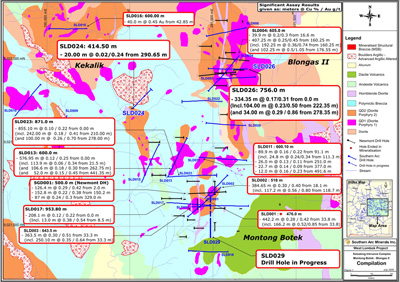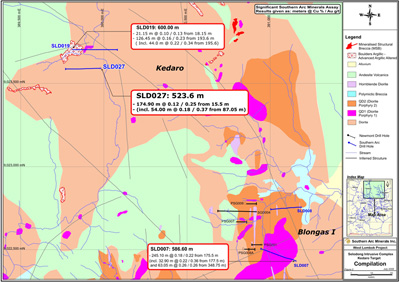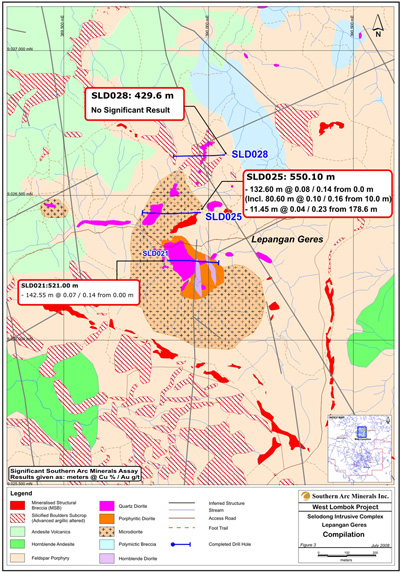Southern Arc Releases Drill Results from Drill Holes SDL024 to SLD028 at the Selodong Porphyry Cu-Au Prospect
SLD026, located at Blongas II mid-way between SGD002 and SLD005 (Figure 1), intersected mineralization analogous to that seen in hole SLD004.SLD026 intersected mineralization from the surface comprising:
| 334.35 m @ 0.17 % Cu and 0.31 g/t Au from 0.00 to 334.35 m |
|
| including |
104.0 m @ 0.23 % Cu and 0.50 g/t Au from 222.35 to 326.35 m |
| and |
34.00 m @ 0.29 % Cu and 0.86 g/t Au from 278.35 to 312.35 m |
SLD026 confirms continuity of Cu-Au mineralization previously intercepted in SLD004 (407.25 m @ 0.25 % Cu and 0.45 g/t Au, including 192.25 m @ 0.36 % Cu and 0.74 g/t Au) on the eastern side of a N-S trending post-mineral diorite dyke. Mineralization on the western side of the dyke was not tested as bad ground conditions necessitated abandoning the hole at 756.0 m, short of the 1000.0 m planned target depth.
SLD026 was drilled westward at an inclination of -72 degrees to a depth of 756.0 m. From surface to a depth of 415.0 m variably phyllic overprinted and mineralized quartz diorite was cored, with a fault‑bounded wedge of post-mineral diorite dyke and meta-sediment intersected between 155.7 m and 222.35 m. From 415.0 m to the end of the hole, a number of post-mineral diorite dykes with locally developed sheared fault-zones increasing to the bottom of the hole were intersected.
Kedaro
The Kedaro target remains compelling as mineralization remains largely unexposed at surface and localized zones of elevated surface geochemistry with supporting magnetic anomalism occur along an 800 m plus NW trend. The Kedaro area may therefore be analogous to the structure-controlled Blongas I – Blongas II trend and remains only partially drill tested.
SLD027 located at Kedaro successfully intersected a southerly extension of mineralization returning an intercept of:
| 174.90 m @ 0.12 % Cu and 0.25 g/t Au from 15.50 to 190.40 m |
|
| including |
54.00 m @ 0.18 % Cu and 0.37 g/t Au from 87.05 to 141.05 m |
SLD027 was drilled westward at an inclination of -65 degrees to a depth of 523.6 m. Variably altered and mineralized quartz micro-diorite was cored from surface to a depth of 190.4 m, with narrow post‑mineral dykes at 35.4 m and 70.0 m. From 190.4 m to the end of the hole, logged core was predominantly non-mineralized medium-grained diorite, with locally abundant primary magnetite. Fault‑bounded meta-sediment wedges were noted between 301.35 m to 373.10 m. The local abundance of primary disseminated magnetite in the non-mineralized diorite causes the magnetic anomaly at least in this part of the Kedaro anomaly.
Lepangan Geres
SLD025 and SLD028 were drilled at Lepangan Geres, the most northerly porphyry target within the Selodong Intrusive Complex, approximately 7.5 km along strike of the same N-NW structure that hosts the Montong Botek, Blongas I and Blongas II porphyry targets (Figure 3). The target area lies on the margin of a large circular magnetic "high” and at the intersection of regional N-S and E-W fault structures. SLD025 and SLD028 were the second and third holes drilled to test the 600 m by 300 m north trending zone of anomalous quartz stockworks at Lepangan Geres.
SLD025, located 160 m north of SLD021, was drilled westward at an inclination of -70 degrees to a depth of 550.1 m. Surface sampling of quartz stockworks in the target area had previously reported significantly anomalous results, including 35.0 m @ 0.12 g/t Au. From surface to a depth of 196.1 m variably phyllic over-printed and weakly mineralized micro-diorite was cored. This zone returned the only significant mineralization within the hole with a low-grade Cu-Au intercept of:
| 132.60 m @ 0.08 % Cu and 0.14 g/t Au from 0.0 to 132.6 m |
|
| including |
80.60 m @ 0.10 % Cu and 0.16 g/t Au from 10.00 to 90.60 m |
From 196.1 m to the bottom of the hole, non-mineralized and intensely phyllic over-printed micro‑diorite with low density quartz-stockwork is cross-cut by a series of later diorite intrusives and localized monomictic breccia.
SLD028 was located a further 200 m north of SLD025 to test the northern extension of the target area. Surface sampling at this locality indicated significant anomalism along a north trending zone of quartz stockworks which returned 55.0 m @ 0.31 g/t Au.
SLD028 was drilled westward at an inclination of -65 degrees to a depth of 429.6 m. From surface to a depth of 214.0 m micro-diorite with localized zones of moderately developed quartz stockwork were intersected. Stockworking within the micro-diorite showed little indication of copper mineralization, probably due to later destructive phyllic overprinting. From 214.0 m to the end of the hole altered volcanics are variably intruded by younger diorite dykes. No significant results were reported.
Extensive zones of quartz-stockwork with corresponding strong gold anomalism from surface sampling indicated the potential presence of a significant porphyry system at Lepangan Geres. Drilling has confirmed the presence of a structurally-controlled porphyry alteration system, but Cu-Au grades are of low tenor, most likely attributable to later phyllic overprinting.
NW Montong Botek
SLD024 was targeted to test for a potential NW extension linking Montong Botek to the Kekalik target, 600 m to the NW (Figure 1). The target area of SLD024 was supported by locally outcropping quartz‑stockworks and a broad zone of elevated Cu+Au soil geochemistry.
SLD024 was drilled NE at an azimuth of 045 degrees, at an inclination of -65 degrees to a depth of 414.5 m. Polymictic breccia was cored from surface to the end of the hole, with narrow late diorite dykes cross-cutting the breccia at 1.0 m and 180.0 m. The breccia comprises predominantly non‑mineralized clasts of volcanic, meta-sediment and increasingly more propylitically altered diorite to the bottom of the hole. Only a narrow zone of low-grade gold mineralization, 20.00 m @ 0.24 g/t Au from 290.65 m was intersected within a zone of mineralized breccia clasts. The elevated Cu+Au soil geochemistry at the target is attributable to concentrations of mineralized clasts within the polymictic breccia.
Current Drilling Activity
Drill rigs 2 and 3 were demobilized during July, while the results from Selodong Phase 1 drilling are further evaluated. Ongoing field work is currently focused on preparation for drilling of extensive epithermal gold targets at the Pelangan and Mencanggah prospects. Rig 1 is currently drilling SLD029 testing the southern part of the Montong Botek target (Figure 1). One to two more holes will be drilled as part of the current program at Blongas II and possibly Kedaro.
The Montong Botek – Blongas I – Blongas II – Lepangan Geres trend has shown the potential to host economic grades of porphyry Cu+Au mineralization. Exploration has shown other early indications of Cu+Au mineralization outside of the drilled areas along this 12km long trend. Ongoing surface work will continue to evaluate the potential of this porphyry trend.
Qualified Person and Quality Control and Assurance
The information in this release has been compiled under the supervision of Southern Arc's Vice President of Exploration Hamish Campbell B.Sc.Geology, MAusIMM. Mr. Campbell has over 23 years of international mineral exploration experience including 21 years in Indonesia during which he has held such positions as Exploration Manager, Senior Geologist and Consulting Geologist. Mr. Campbell has sufficient experience relevant to the style of mineralization under consideration and qualifies as a Qualified Person as defined in terms of NI 43-101.
All assaying of samples was undertaken by the ITS laboratory in Jakarta. ITS is one of the world's largest product and commodity testing, inspection and certification organizations. The Jakarta laboratory is ISO 17025 accredited and employs a Laboratory Information Management System (LIMS) for sample tracking, quality control and reporting. In addition to the laboratory's quality assurance program, the Company employs its own comprehensive quality assurance/control program including blanks and standards, along with reassays of selective drill pulps by independent industry-accredited laboratories.
On behalf of the Board of
Southern Arc Minerals Inc.
"John Proust”
President and CEO
For more information please contact:
Southern Arc Minerals Inc.
c/o John G. Proust, CEO
Telephone: (604) 676-5241 Fax: (604) 676-5246
Email: This email address is being protected from spambots. You need JavaScript enabled to view it.
Website: http://www.southernarcminerals.com/
"The TSX Venture Exchange does not accept responsibility for the adequacy or accuracy of this release”.





